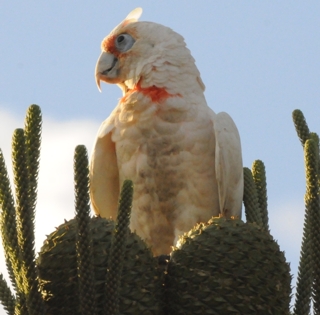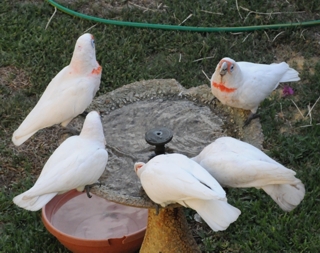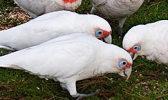
Corellas are one of the most visible birds in many Australian cities, any proposal to cull their numbers inevitably causes some controversy. Like humans, they may be recent inhabitants of an area but are they occupying an environmental niche that we created ?
Recently an article published by the Wimmera Mail-Times regarding a proposed corella cull caught my attention. It’s not unusual for this subject to come up in just about any state in Australia as corellas seem to be popping up everywhere, don’t they? The article consists mainly of rhetoric coming from Horsham Councillor Gary Bird (yes that is his real name) and Cr Bernard Gross. Cr Bird calls for gun laws to be relaxed and field and game shooters to be allowed to join in a corella cull though he doesn’t want to paint a picture of the ol’ wild west. Cr Gross isn’t as shy about the wild west theme, it would seem that “shoot outs” were used to keep numbers down when he was a boy. Along with damaging property and the environment, corellas are also accused of predating on other birds by Horsham Mayor Michael Ryan. To add fuel to the fire, it seems these corellas aren’t from these parts anyway….. they’re from out west, Western Australia to be precise.
These corellas aren't from these parts!

Longbill showing off his assets
So who are these pesky, carnivorous, white-feathered invaders anyway? They appear to be little corellas, a species that appears to originate from the arid and semi-arid regions of inland Australia. Much like kangaroos, their original range before white settlement is subject to debate. Some say that little corellas are expanding coastward in many parts of Australia, others that aviary releases are increasing their range. I would suggest however that the little corellas found in Horsham, Victoria originate from somewhere a lot closer than Western Australia. I would also suggest that the mayor of Horsham check his facts regarding their carnivorous nature. Perhaps he is getting confused with the corellas tendency to compete with other birds over nesting sites. The statements made about the little corella in Horsham however, could be classified as restrained in comparison to the propaganda coming out of Old Noarlunga, South Australia in 2008. A suggestion is made that the birds may have escaped from aviaries, its origin (via DNA testing) could possibly trace it back to the Philipines. The little corella seems to be getting further and further from “home” all the time.
Which corella?
The corella issue crops up commonly in urban areas such as the proposed cull in Busselton, Western Australia as pointed out by RichB In WA the term “corella” gets used very loosely by local government to describe any white parrot they deem to be a nuisance. The corella species that inhabit Perth currently are not endemic to the area as many pro-culling residents are quick to point out, though there appears to be the occasional sighting of Butler corellas (the northern subspecies of the western longbill corella). What is not so commonly known is that the endangered Muir’s corella (another subspecies of western longbill corella) were originally found in the Perth area. Unfortunately they disappeared over 100 years ago and can now only be found in a small area deep in the southwest of WA. Loss of habitat, shooting and poisoning appear to be the main reason for their demise in the Perth area and other south west regions (including Busselton). As yet I have not heard any mention of a possible re-introduction of Muir’s corellas in Perth to accompany the eradication of the little corella and (eastern) longbill corella. Given that the Muir corella is larger than both of the introduced species and displays very similar behaviour ie. Active, noisy and conspicuous, I wonder how well received this bird would be.
Culling for convenience

Enjoying a few drinks, this time they left the garden hose alone
Attempts to demonise a bird species by claiming it’s not endemic to the area often occurs during proposed culls particularly in urban areas. In Perth there have been claims that Australian ravens are not endemic to our coastal strip by those campaigning for culling. The Perth suburb of Mosman Park however needed no such justification to get government approval for their own raven cull In this case the persistence of several vocal ratepayers in Mosman Park appeared to be reason enough to go ahead with the cull. Other wildlife culls proceed as a matter of routine such as the annual killing of endemic wood ducks at Burswood Casino Golf Course. . In this case Burswood management deemed (as they do every year) that the resident wood duck population was too large…. This is a similar argument used by those requesting kangaroo culls in urban areas such as the proposed cull at Preston Beach Golf Club
Where have the natural predators gone?
Corellas are killed in their thousands in agricultural areas, obviously these culls don’t attract the same sort of attention as those in the city. A natural way of keeping corella numbers down is via the predation by raptors such as the peregrine falcon and the wedge tailed eagle. Unfortunately these birds have also been blasted out of the sky, poisoned directly or indirectly or have lost most of their habitat due to land clearing, the wedge tailed eagle is still listed as an agricultural pest in Western Australia to this day. Understandably there are those who question whether humans will ever evolve beyond the “go for the gun” mentality in attempting to control or improve our environment. It does seem however that using raptors to scare away corellas is becoming more popular, I know of a landowner who periodically uses (captive) goshawks for this purpose.
Role of the pet industry and the FATE program
No corella discussion would be complete without mention of the pet industry’s contribution to the current range of corella species. It is widely accepted that the presence of little corellas and (in most cases) long billed corellas in our major cities is due to aviary releases / escapes. If we are trying to manage these bird populations why is it that any individual (in WA at least) can walk into a pet store and buy one of these birds? In WA you can own up to 10 corellas without having a permit. There is some control attempted at the local government level but this message is lost amongst the chit-chat captive corellas engage us with in pet stores. In WA rainbow lorikeets are freely available as pets even as this introduced bird (by aviary release/escape) begins to penetrate the jarrah forests in Perth’s hills in direct competition with endemic birds such as the red capped and twenty eight parrot. Incidentally, endemic birds are also available at bird shops whether they are listed as agricultural pests or endangered (or both) It is very disturbing to find birds such as endangered black cockatoos in specialist bird shops with price tags going into tens of thousands of dollars. Whilst these birds may have been hand reared and are therefore not releasable into the wild, there is no doubt the prices commanded by these rare birds surely promotes illegal activity in the bird trade to maintain supply. Professor Mike Archer’s Future of Australia’s Threatened Ecosystems (FATE) program is promoting the use of native animals as pets, one only has to look at the pet bird industry to appreciate the potential damage this practice can inflict both environmentally and on the species involved. Placing a value on a native species tantamount to its decline in wild populations particularly if that value is high. Inevitably, a commercially valued species is subject to illegal activities. The collecting of eggs from species such as the peregrine falcon, wedge tailed eagle and Muir’s corella are testament to this.
 The NSW Environment Protection Authority (EPA) is calling for the public’s help in its investigation into the suspected mass poisoning of hundreds of native Corella birds across multiple Newcastle suburbs, including Hamilton, Carrington, Waratah, Broadmeadow, Lambton, and near Newcastle University. The EPA received initial reports on Monday 17 March 2025 of 14 sick and dead birds in Hamilton but by midday reports had escalated to hundreds of affected birds in Carrington and surrounding areas.
The NSW Environment Protection Authority (EPA) is calling for the public’s help in its investigation into the suspected mass poisoning of hundreds of native Corella birds across multiple Newcastle suburbs, including Hamilton, Carrington, Waratah, Broadmeadow, Lambton, and near Newcastle University. The EPA received initial reports on Monday 17 March 2025 of 14 sick and dead birds in Hamilton but by midday reports had escalated to hundreds of affected birds in Carrington and surrounding areas.



Recent comments